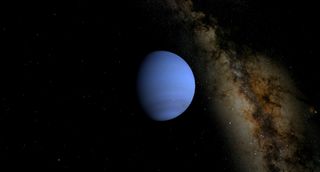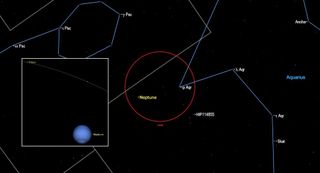Neptune reaches opposition today: How to see the distant planet
Observing the planet requires a pair of binoculars or a small telescope.

The solar system's outermost planet, Neptune, reaches opposition today — here's how you can catch a glimpse of the distant gas giant.
Planet Neptune reached opposition today (Sept. 14) at about 5 a.m. EDT (0900 GMT), when Earth passed directly between the sun and Neptune, according to EarthSky.org. Opposition occurs when two astronomical objects — in this case, the sun and Neptune — are on opposite sides of the sky as seen from Earth. As a result of this cosmic alignment, Neptune will appear bigger and brighter in the sky than at any other time of the year (though you’ll still need a pair of binoculars or a small telescope to see it.)
During opposition, Neptune rises in the east as the sun sets in the west, offering skywatchers the best views after 9 p.m. local time. However, the planet will be visible and especially spectacular throughout most of the night tonight, in front of the constellation Aquarius, reaching its highest point in the night sky around midnight local time.
Related: Night sky, September 2021: What you can see this month [maps]

Yesterday (Sept. 13), Neptune also passed perigee, or the closest point to Earth in its orbit, at a distance of 2.7 billion miles (4.3 billion kilometers), making it appear its brightest all year. The planet made its closest approach to Earth about 20 hours before opposition. Nevertheless, as the eighth planet from the sun, Neptune’s vast distance means it is never visible to the unaided eye — no matter how closely it orbits Earth.
"This world is about five times fainter than the dimmest star you can see on a moonless night under dark skies," according to EarthSky.org. "You’ll need binoculars or a telescope for Neptune, plus a detailed sky chart."
To find Neptune, you can look to the left of the moon and search for the very close by star Phi Aquarii, which is faint, but easily visible to the eye alone on a dark night — without the light from the moon. You can use this guide from The Old Farmer’s Almanac to determine when the moon rises and sets in your area, and plan when you may get the best opportunity to view the planet.
Get the Space.com Newsletter
Breaking space news, the latest updates on rocket launches, skywatching events and more!
Given that Neptune is so faint (even at opposition), we recommend using a good sky chart to help identify the distant planet and its neighboring landmarks in the constellation Aquarius. And while you may be able to glimpse the planet in a good set of binoculars, you’ll most likely have more luck with a telescope at 200 magnification, according to EarthSky.org.
If night sky viewing conditions are bad tonight, however, don't worry! You’ll have more chances to observe Neptune among the stars of Aquarius throughout September.
Follow Samantha Mathewson @Sam_Ashley13. Follow us on Twitter @Spacedotcom and on Facebook.
Join our Space Forums to keep talking space on the latest missions, night sky and more! And if you have a news tip, correction or comment, let us know at: community@space.com.

Samantha Mathewson joined Space.com as an intern in the summer of 2016. She received a B.A. in Journalism and Environmental Science at the University of New Haven, in Connecticut. Previously, her work has been published in Nature World News. When not writing or reading about science, Samantha enjoys traveling to new places and taking photos! You can follow her on Twitter @Sam_Ashley13.